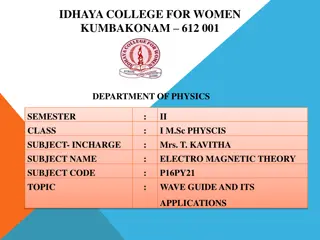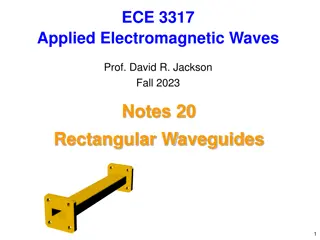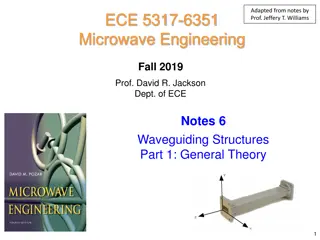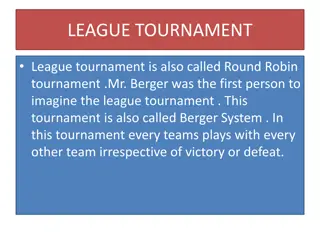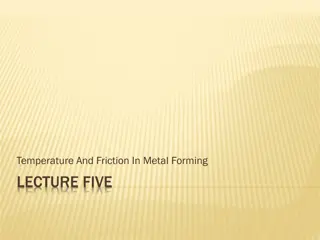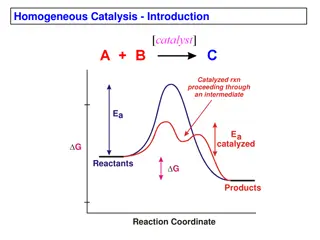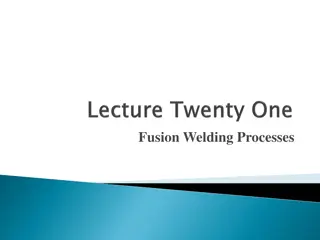Introduction to Waveguides and Their Advantages
Waveguides are structures that transmit electromagnetic waves, offering advantages over traditional transmission lines such as higher power handling capacity, lower loss, and the ability to operate at higher frequencies. They come in different shapes like rectangular and circular, with distinct modes of operation. The dominant mode is the lowest frequency that can propagate in a waveguide, with unique behaviors related to electric and magnetic fields. Understanding waveguide behavior is crucial for efficient signal transmission in various applications.
Download Presentation

Please find below an Image/Link to download the presentation.
The content on the website is provided AS IS for your information and personal use only. It may not be sold, licensed, or shared on other websites without obtaining consent from the author. Download presentation by click this link. If you encounter any issues during the download, it is possible that the publisher has removed the file from their server.
E N D
Presentation Transcript
KNOWLEDGE INSTITUTE OF TECHNOLOGY INTRODUCTION OFWAVEGUIDES Prepared by RAADHU.T ASSISTANT PROFESSOR
INTRODUCTION TOWA VEGUIDES In a waveguide energy is transmitted in theform of electromagnetic waves whereas in transmission line, itis transmitted in the form of voltageandcurrent. Conductionof energytakesplacenot through the wallswhose function is only to confine this energy but through the dielectric filling the waveguide whichis usually air. ADV ANT AGES OF WAVEGUIDE OVER A TRANSMISSION LINE: In a transmission line high frequency signals cannotbe transmitted because Large mutual induction. Length is verylarge. Multiplexing the signals is notpossible in transmission lines. Flashover is less in case of waveguide. Minimum loss of power in case ofwaveguide. Power handling capability is 10 times than coaxialcable. 3
INTRODUCTION TOWA VEGUIDES Mechanicalsimplicity. Higher maximum operating frequency.(3GHZ to100GHZ). Normally waveguides are of twotypes. Rectangularwaveguide. Circularwaveguide. a b d Rectangularwaveguide Circularwaveguide REFLECTION OF WAVEFORM IN CONDUCTING PLANE: Vg V is velocity guided bywall g (groupvelocity) Vn is the normal velocityto wall VI VR Vn 4
DOMINANT MODE OFOPERATION DOMINANT MODE :The natural mode of oper- -ation for a waveguide is called dominant mode. This modeis the lowest possible frequency that can be propagated in a waveguide. a L L a MAGNETI C FIELD ELECTRIC FIELD m=no. of half wavelengthacross waveguide. n=no. of half wavelengthalong the waveguide height. L > > > a 5
DOMINANT MODE OF OPERATION cont n=1 => 1 circle n=2 => 2 circles m- electricfield n magneticfield The signal of maximum wavelength that can pass througha waveguideis 0=2a/m BASICBEHAVIOUR Magnetic field m=1 m=2 An electromagnetic plane wave in space is transverseelectrom- agnetic or TEM. The electric field, the magnetic field and direction of propagation are mutually perpendicular. If such a wave were sent straight down a waveguide, it would not propagatein it. Thisis becausethe electric field would be short-circuited bythe wallssince the wallsareassumedto be 6
BASIC BEHAVIOURcont. Perfect conductors and a potential cannotexist acrossthem. What must be found in some method of propagation which doesn t require an electric field to exist near a wall and simultaneously the parallel to it. This is achieved by sending the wave down the waveguide in a zigzag fashion bouncing it off the wallsandsettingof afield i.e.,maximaat the centreof waveguide and zero at thewalls. Inthis case,the wallsarenothing to beshort circuitandthey don t interferewith the wavepatternsetupbetween them. T omeasure consequences of zigzag propagation are apparent. Thefirst isthat velocity of propagationin awaveguidemustbe lessthan that of freespace. 7
PLANE WA VE OF A CONDUCTINGSURF ACE If actual velocity of wave is Vc , then the simple trigonometry shows that the velocity of the wave in the direction parallel to conducting is Vg and velocity normalto the wall isVn. Vg P REFLECTED WA VE INCIDENT WA VE VC Vn n P ARALLEL AND NORMAL WA VE LENGTH:Distance between 2 successive identical points i.e., successive crests or successive troughs. In the figure, it is seen that the wavelength in direction of propagation of wave is being the distance between 2 successive crests in thisdirection. 8
P ARALLEL AND NORMAL WA VELENGTHcont. So the distance between 2 consecutive crestsin the direction parallel to conducting plane is p andwavelength perpendicular to surface is n. = sin cos Vg = VCsin Vp=f p=f =VC sin Vp phase velocity velocity with which wave changesits phase. Vg group velocity velocity parallel towall. P ARALLEL PLANEWAVEGUIDE Inorder to wave to propagatein awaveguidethere shouldbe no voltage at the walls because walls are purely conductive if there exists some voltage at walls the wave get shorted and there will be no propagation ofwave. n = VC = f p Eq1 sin 9 BT14ECE031 CHARAN SAIKATAKAM VNIT
P ARALLEL PLANE WAVEGUIDEcont.. Voltage variation in waveguide is almostsimilar to the transmissionlines. Waveform of voltage in transmission lines is asfollows /2 2 /2 3 /2 So dimension of waveguide can have following valuessuch that voltage at walls willbe zero. a= n / 2 a=2 n / 2 a=3 n / 2 10
DERIVATION OF CUT OFFWA VELENGTH a is the distance between the walls n is the wavelengthin the direction normalto both walls. m isthe no.of half wavelengthof electric intensity to be established between walls which is nothing butinteger. a=m n= m 2cos m cos =2a = = From Eq1 2 P sin 1-(m )2 (2a)2 1-cos2 From equation , it is easy to say that as the free space wave length is increased, there comes a point beyond which, the wave can no linger propagate in a waveguide withfixed a & m . The free space wavelength at which this takes place is calledcut off wavelength andit definesasthe smallestfree 11
DERIVATION OF CUT OFFWA VELENGTH Space wavelength that is just unable topropagate in waveguide under suchcondition. 1- 2a ( ) o =2a 2= 0 m o m o=cut off wavelength for dominant mode,m=1, o=2a p = 1 - (m )2 p= 1 -( ) p = guided wavelength = free spacewavelength 2a 2 o So a waveguide allows a signal having a frequency more than cut off frequency so a waveguide acts as high passfilter. The lowest cut off frequency can be calculatedthrough fc=1.5*108 n b) 2 m a ( )2+(
PROBLEM Calculate the lowest frequency anddetermine the mode closest to the dominant mode of rectangular waveguide 5.1cm*2.4cm.Calculate the cut off frequencyof dominant mode? Ans)Fromthe formula in previous slidefor dominant modeis TE1,0 so m=1,n=0,a=5.1*10-2 ,b=2.4*10-2 weget fc =2.94GHz Mode closest to dominant mode can be determinedby substituting m , nvalues. for m=0, n=1, we get fc=6.25GHz for m=0, n=2, we get fc=12.5GHz for m=2,n=0,we get fc=5.8GHz Asfc=5.8GHzin TE2,0iscloseto fc=2.94GHzin TE2,0,therefore mode closestto dominant mode isTE2,0. 13
GROUP AND PHASE VELOCITY INWAVEGUIDE Vc Vg V =V sin Vp Vg = (Vc )2 ------Eq2 Vp=f p V =f 1-( Vp= 1- ( ) V = sin g c p p Vc Vn n p o)2 Vc o 2 Substituting above equation in Eq 2 weget Vg =Vc The above equation represents that velocity of propagationor group velocity in a waveguide is lower than in free space. Group velocity decreases as the free space wavelength approaches the cut off wavelength and is zero when the two wavelength areequal. ( 1- ( ) ) 2 o 14
PROBLEM It is necessary to propagate a 10GHz signal ina waveguide whose wall separation is 6cm.What is the greatest no.of halfwaves of electric intensity which it will possible to establish between 2 walls. Calculate the guide wavelengthfor this mode ofoperation? Solution: a = 6 cm , f = 10GHz => = f/c =3cm 0 =(2*a)/m for m=1 => 0 =12/1 =12 cm for m=2 => 0 =12/2 =6cm for m=3 => 0 =12/3 =4cm for m=4 => 0 =12/4 =3cm So maximum value of m is4. 15


